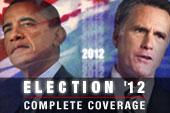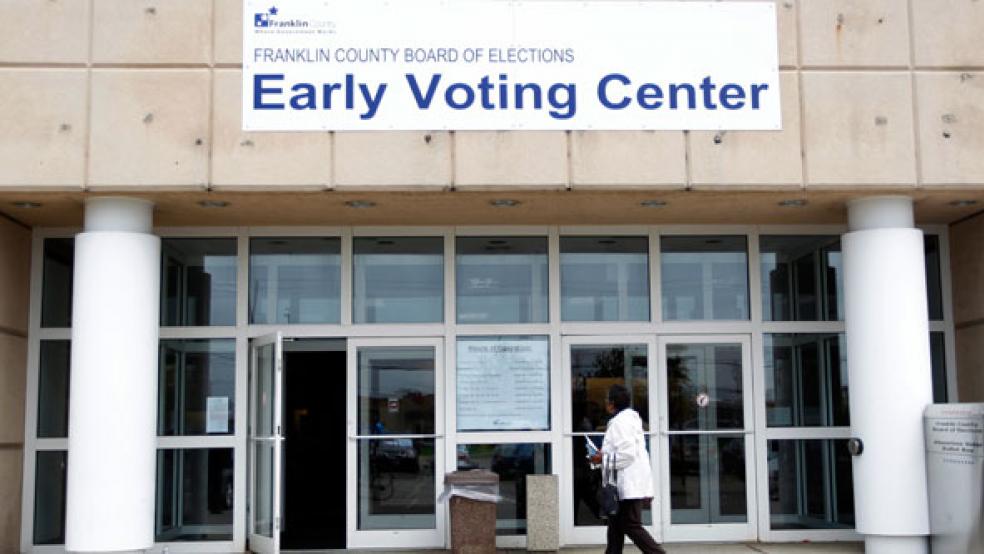President Obama has pinned his reelection hopes on early voters, a group that’s not necessarily captured by recent polls showing that momentum has shifted to Republican Mitt Romney.

Voters in critical swing states such as Colorado, Florida, Iowa, Ohio and North Carolina are already casting ballots by mail or in-person—and more than 30 percent of the country are projected to have voted before election day on Nov. 6. Even though the election often seems to be about political messaging, it ultimately depends on campaign logistics.
The Obama team argues that the additional days will help them increase Democratic turnout. Obama campaign manager Jim Messina told reporters on a Tuesday conference call that they’re outperforming “our early-vote margins in key states compared to 2008.”
“What early vote does is help us get out our low propensity voters -- voters called sporadic voters -- which broadens our universe and frees up more ‘get out the vote’ resources later, especially on election day,” Messina said. “Our numbers and public numbers are showing that more Obama sporadic voters are voting than Romney sporadic voters, which is a very big piece of business for the total turnout.”
Republicans counter—predictably—that the numbers look better for them.
“In most cases, the data show Republicans making up a larger share of early voters this year than they did four years ago,” Rob Wile, political director for the Republican National Committee, wrote in a memo released yesterday. “Democrats make up a smaller share, giving Republicans an important advantage.”

But it’s not quite that simple, since early voting is different among states and changes as the election approaches. First of all, academic analysis drawing of the past two presidential elections reveals that early voting decreased turnout.
The extended time to vote removes the urgency attached to Nov. 6, in the same way a grocery store shopper can be rendered indecisive by choosing among a hundred different boxes of cereal, said Barry Burden, a University of Wisconsin-Madison professor who conducted the research based on Census Bureau and county records. “It saps the power of an election day to get people to the polls,” Burden said. “Especially if it’s done by mail and there is no face-to-face interaction, you lose the punch of a traditional election day.”
The type of early voting is also critical, since Republicans generally perform better with mail-in ballots while in-person voting tends to benefit Democrats.
FLORIDA
Florida—which is already accepting votes by post and begins in-person on Saturday—reflects that schism. Of the more than 800,000 Floridians who have already voted by mail, 44.8 percent were registered Republican, 39.4 percent were Democratic, and 15.8 percent were independent, according to The Miami Herald. That gap—which appears to be smaller than in 2008—should narrow in the Democrats’ favor once voters begin to visit their local polling places. About 54 percent of the 8.45 million Floridians who voted four years ago did so before election day.
OHIO
Mail could be a major factor in Ohio, which might be the most essential swing state for Obama and Romney to win. “Ohio has taken the unusual step of mailing an absentee ballot to every registered voter,” Burden said. “By giving this ballot out automatically, it’s going to jump to new levels.”
The Buckeye State began early voting on Oct. 2. Almost 30 percent of Ohio voted early in 2008. About 113,830 have already cast ballots in Cuyahoga County, the Democratic stronghold where Cleveland is located. More Republicans are voting early in Cuyahoga County, but their numbers are still overwhelmed by Democrats. This essentially means—not surprisingly—that Romney is faring better than Arizona Sen. John McCain, the GOP nominee in 2008.
Because of how party affiliation is declared in Ohio, “it is next to meaningless to divine who is ahead” in that critical state, said Michael McDonald, a George Mason University who tracks early voting, in a blog post last week.
However, the numbers in Cuyahoga County indicate that these are people who would be going to the polls anyway. “They are highly participatory people who tend to vote in primaries,” McDonald wrote. “Let me put this another way, people who vote the earlier are people who just generally vote.”
NORTH CAROLINA
North Carolina began in-person the previous Thursday—and 150,872 people showed up that first day. More than 817,000 have voted thus far, 88 percent of them in-person. Unlike any other state, people can register and vote in a “one stop” visit, which roughly 100,000 did in the previous presidential race.
These unregistered voters do not get included in surveys that project Romney as the clear winner. And in early voting in North Carolina thus far, 51.2 percent are Democrats, 30.2 percent are Republican and 18.6 percent are unaffiliated, according to state records. The Obama campaign recognizes this phenomenon and even produced a special video targeted at North Carolina voters.
“When you vote early, we want you to ask one more person to vote early with you,” Michelle Obama says in the clip. “Make sure that one nephew, that one co-worker, that one neighbor votes early for Barack right along with you.”




